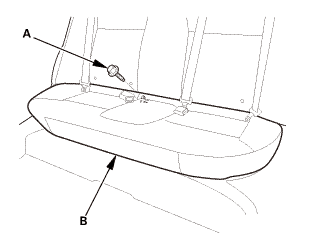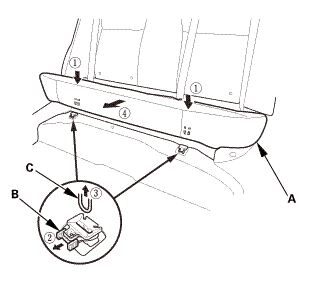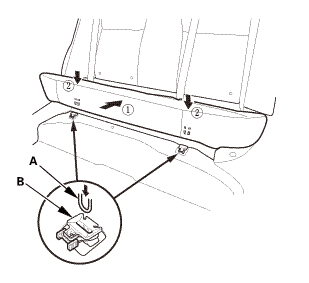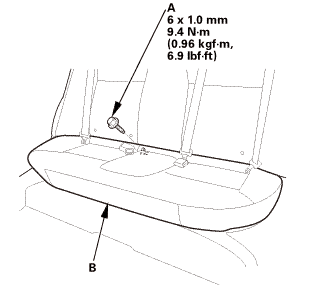Honda Civic Service Manual: Fuel Tank Removal and Installation (R18A9)


Compressed natural gas is flammable and highly explosive. You could be killed
or seriously injured if leaking natural gas is ignited.
Stop the engine, and keep heat, sparks, and flames away.
|
|
1.
|
Raise the vehicle on a lift, and make sure it is securely supported.
|
|
| 2. |
Fuel Pressure - Relieving (Between the fuel tank and the engine) (Natural
Gas Model) |
|

|

Compressed natural gas is flammable and highly explosive. You could be
killed or seriously injured if leaking natural gas is ignited.
Stop the engine, and keep heat, sparks, and flames away.
|
This procedure should be done outside in a well-ventilated area
or in a properly equipped CNG shop.
|
|
This procedure will allow you to safely work on any part of the
fuel system downstream of the fuel tank such as the fuel joint block
or the manual shut-off valve.
|
|
NOTE: Make sure the manual shut-off valve is open.
|
|
3.
|
Disconnect the connector (A) (this prevents the tank from supplying
fuel to the system).
|
|
4.
|
Start the engine, and let it idle.
|
|
5.
|
After a few minutes, the engine will stall.
|
|
6.
|
Turn the ignition switch to LOCK (0).
|
|
| 3. |
Rear Floor Undercover (Natural Gas Model) |
|

|
|
1.
|
Remove the rear floor undercover (A).
|
|
| 4. |
Fuel Pipes at the Fuel Joint Block (Natural Gas Model) |
|

|
|
1.
|
Remove the three fuel pipes (A) at the fuel joint block (B) and
the two fuel joint block mounting bolts (C).
|
|
NOTE: Always use two wrenches when removing fuel pipe nuts.
|
|
| 5. |
Lower The Vehicle On The Lift |
|
|
1.
|
Lower the vehicle on the lift.
|
|
| 6. |
Left Rear Door Panel Assembly (Natural Gas Model) |
|

|
|
1.
|
Remove the left rear door assembly (A).
|
|
|

|
|
2.
|
Disconnect the connector (A).
|
|
|

|
|
1.
|
Remove the bolt (A) securing the rear seat cushion (B).
|
|
|

|
|
2.
|
While pushing down the rear seat cushion (A), pull the seat hook
handles (B) to release the hooks (C).
|
|
3.
|
Remove the rear seat cushion.
|
|
| 8. |
Center seat belt buckle bolt |
|

|
|
1.
|
Remove the center seat belt buckle bolt (A) at the floor.
|
|
| 9. |
Rear Seat-Back (Natural Gas Model) |
|

|
|
1.
|
Release the center seat belt (A) from the center belt guide (B).
|
|
|

|
|
3.
|
Remove the rear seat-back (A).
|
|
|

|
|
1.
|
Pull out the C-pillar trim (A) to release the clips.
|
|
2.
|
Remove the C-pillar trim.
|
|
NOTE: The front clip (B) will stay in the body.
|
|
3.
|
The left side is shown; repeat on the right side.
|
|
|

|
|
4.
|
Remove the front clip (A).
|
|
5.
|
The left side is shown; repeat on the right side.
|
|
| 11. |
Rear Shelf (Natural Gas Model) |
|

|
|
1.
|
From the trunk compartment, disconnect the connector (A).
|
|
|

|
|
2.
|
From the trunk compartment, detach the clips (A).
|
|
|
3.
|
Pull out both rear seat belts (A) and the rear center seat belt (B) through
the slits in the rear shelf trim (C), then remove the rear shelf trim.
|

| 12. |
Trunk Floor Lid (Natural Gas Model) |
|

|
|
1.
|
Remove the trunk floor cover (A).
|
|
| 13. |
Trunk Front Trim Panel (Natural Gas Model) |
|

|
|
1.
|
Remove the trunk front trim panel (A) and the trunk partition
(B) as an assembly.
|
|
| 14. |
Fuel Tank Protector (Natural Gas Model) |
|

|
|
1.
|
Remove the fuel tank protector (A).
|
|
| 15. |
Rear Bulkhead Gusset Both Sides (Natural Gas Model) |
|

|
|
1.
|
Remove the gussets (A).
|
|
| 16. |
Rear Parcel Cover (Natural Gas Model) |
|

|
|
1.
|
Disconnect the speaker connectors, and remove the rear parcel
cover (A).
|
|
| 17. |
Rear Shelf Gusset Both Sides (Natural Gas Model) |
|

|
|
1.
|
Remove the rear shelf gussets (A) in the trunk.
|
|
| 18. |
Rear Floor Upper Crossmember Gusset (Natural Gas Model) |
|

|
|
1.
|
Remove the rear floor upper crossmember gusset (A).
|
|
| 19. |
Fuel Tank Assembly (Natural Gas Model) |
|

|
|
2.
|
Disconnect the vent hose (A).
|
|
|

|
|
3.
|
Remove the tank frame mounting bolts (A).
|
|
|

|
|
4.
|
Push the front seats forward, then cover the seats and the floor
with a tarp or similar material.
|
|
5.
|
With the help of two other technicians, lift the frame, and slide
the entire fuel tank assembly (A) into the passenger compartment.
Be careful not to damage the fuel joint block.
|
|
6.
|
Rotate the fuel tank so the fuel joint block and the frame can
clear the left rear door opening, then carefully remove the fuel
tank assembly from the vehicle.
|
|


Compressed natural gas is flammable and highly explosive. You could be killed
or seriously injured if leaking natural gas is ignited.
Stop the engine, and keep heat, sparks, and flames away.
| 1. |
Fuel Tank Assembly (Natural Gas Model) |
|

|
|
1.
|
With the help of two other technicians, lift the frame, and slide
the entire fuel tank assembly (A) into the passenger compartment
from outside the vehicle. Be careful not to damage the fuel joint
block.
|
|
2.
|
Carefully set the fuel tank assembly to the proper position.
|
|
|
 3s 3s
|
|
3.
|
Install the tank frame mounting bolts (A).
|
|
|

|
|
4.
|
Connect the vent hose (A).
|
|
|

|
|
5.
|
Install the bolts (A).
|
|
| 2. |
Rear Floor Upper Crossmember Gusset (Natural Gas Model) |
|

|
|
1.
|
Install the rear floor upper crossmember gusset (A).
|
|
NOTE:
|
|

|
Tighten the bolts by hand first, then tighten
them to the specified torque.
|
|
|

|
Tighten the bolts to the specified torque in
the sequence shown.
|
|
|
|
| 3. |
Rear Shelf Gusset Both Sides (Natural Gas Model) |
|

|
|
1.
|
Remove the rear shelf gussets (A) in the trunk.
|
|
| 4. |
Rear Parcel Cover (Natural Gas Model) |
|
 on on
|
|
1.
|
Install the rear parcel cover (A), and reconnect the speaker
connectors.
|
|
| 5. |
Rear Bulkhead Gusset Both Sides (Natural Gas Model) |
|
 22 22
|
|
1.
|
Install the gussets (A).
|
|
| 6. |
Fuel Tank Protector (Natural Gas Model) |
|

|
|
1.
|
Install the fuel tank protector (A).
|
|
| 7. |
Trunk Front Trim Panel (Natural Gas Model) |
|

|
|
1.
|
Install the trunk front trim panel (A) and the trunk partition
(B) as an assembly.
|
|
| 8. |
Trunk Floor Lid (Natural Gas Model) |
|

|
|
1.
|
Install the trunk floor cover (A).
|
|
| 9. |
Rear Shelf (Natural Gas Model) |
|
1.
|
Slip the rear seat belts (A) and the rear center seat belt (B) through
the slits in the rear shelf trim (C).
|

|

|
|
2.
|
Install the clips (A).
|
|
|

|
|
3.
|
From the trunk compartment, connect the connector (A).
|
|
|

|
|
1.
|
Install the new front clip (A) to the C-pillar trim (B).
|
|
|

|
|
2.
|
Install the C-pillar trim (A).
|
|
NOTE:
|
|

|
Make sure the side curtain airbag is not tucked
under the clips or the ribs.
|
|
|

|
Do not push too hard on the C-pillar trim. If
you push too hard, the clip will be damaged, and
it will not hold the trim properly.
|
|
|

|
Gently tug on the C-pillar trim to verify that
all clips are securely fastened.
|
|
|
|
3.
|
The left side is shown; repeat on the right side.
|
|
| 11. |
Rear Seat-Back (Natural Gas Model) |
|

|
|
1.
|
Install the rear seat-back (A).
|
|
|
 m.imim m.imim
|
|
2.
|
Install the bolts (A).
|
|
|

|
|
3.
|
Install the center seat belt (A) to the center belt guide (B).
|
|
| 12. |
Center seat belt buckle bolt |
|
 32 32
|
|
1.
|
Install the center seat belt buckle bolt (A).
|
|
|

|
|
1.
|
Install the hooks (A) to the rear seat cushion clips (B).
|
|
|

|
|
2.
|
Install the bolt (A) securing the rear seat cushion (B).
|
|
| 14. |
Left Rear Door Panel Assembly (Natural Gas Model) |
|

|
|
1.
|
Connect the connector (A).
|
|
|

|
|
2.
|
Install the left rear door assembly (A).
|
|
| 15. |
Door Position - Adjustment (4-door) |
|
Front
 mm mm
Rear

|
|
NOTE: Check for a flush fit with the body, then check for equal
gaps between the front and rear doors, and between the doors, and
the body. Check that the door and body edges are parallel.
|
|
1.
|
Place the vehicle on a firm, level surface when adjusting the
doors.
|
|
2.
|
Adjust at the hinges:
|
|

|
Pad a floor jack with shop towels, then use the
jack to support the door while adjusting it.
|
|
|

|
Loosen the hinge mounting bolts (A) slightly,
and move the door backward or forward, up or down
as necessary to equalize the gaps.
|
|
|
|
3.
|
If necessary, replace the door mounting bolts with the adjusting
bolts made specifically for door adjustment, then adjust at the
door: Loosen the door mounting bolts (B) slightly, and move the
door up or down as necessary to equalize the gaps, and move it in
or out until it's flush with the body.
|
|
NOTE: Refer to the Parts Catalog if you need use an adjusting
bolt.
|
|
|

|
|
4.
|
Check that the door and body edges are parallel. If necessary,
adjust the door cushions (A) to make the rear of the doors flush
with the body.
|
|
5.
|
Apply touch-up paint to the hinge mounting bolts, and around
the hinges.
|
|
| 16. |
Fuel Pipes at the Fuel Joint Block (Natural Gas Model) |
|
 -.25u....m.2n -.25u....m.2n
|
|
1.
|
Install two fuel joint block mounting bolts (A).
|
|
2.
|
Install the three fuel pipes (B) at the fuel joint block (C).
|
|
NOTE: Always use two wrenches when installing fuel pipe nuts.
|
|
| 17. |
Rear Floor Undercover (Natural Gas Model) |
|
 ioumm ioumm
|
|
1.
|
Install the rear floor undercover (A).
|
|
| 18. |
Fuel Tank Fill Procedure (Natural Gas Model) |
|
|
If a tank is empty, has less than 690±340 kPa (7.0±3.5 kgf/cm2,
100±50 psi) of internal pressure and is at an ambient temperature
of 32 °F (0 °C) or less, follow the procedure below. Otherwise,
fill the tank normally.
|
|
1.
|
Fill the fuel tank to 4,800±340 kPa (49.2±3.5 kgf/cm2, 700±50
psi) slowly (from a compressor, not from a cascade storage system).
|
|
3.
|
Fill the rest of the tank normally.
|
|
| 19. |
Manual Shut-off Valve - Open (Natural Gas Model) |
|

|
|
1.
|
Open the manual shut-off valve (A).
|
|
| 20. |
Fuel Supply System Leak - Inspection (Natural Gas Model) |
|

|
|
Check for a gas leak if there is an odor coming from the vehicle.
Compressed natural gas (CNG) can only be smelled, not seen.
|
|
1.
|
Open the hood and the fuel fill door.
|
|
2.
|
Connect a vacuum pump/gauge, 0-30 inHg, to the hose (A) from
fuel pressure regulator P1, and apply 67.7 kPa (20.0 inHg, 508 mmHg)
of vacuum.
|
|
3.
|
If fuel pressure regulator P2 does not hold vacuum, replace it
before continuing to the next step.
|
|
4.
|
Inspect the fuel lines and hoses under the hood for kinks, abrasion,
and other signs of damage.
|
|
5.
|
With the manual shut-off valve open, turn the ignition switch
to ON (II), but do not start the engine.
|
|
6.
|
After the fuel pressure regulator shut-off solenoid valve/fuel
tank internal solenoid valve operates for about 2 seconds, the fuel
pressure in the fuel lines rises.
|
|
7.
|
Turn the ignition switch to LOCK (0).
|
|
8.
|
Repeat this two or three times.
|
|
|

|
|
9.
|
Within 1 minute, check for any damaged lines with a leak detector
(A) (Snap-on Combustible Gas Leak Detector or Snoop Liquid Leak
Detector (B)).
|
|
|

|
|
10.
|
If no damage was noticed during the inspection, turn the ignition
switch to ON (II) for 2 seconds, then turn the ignition switch to
LOCK (0).
|
|
11.
|
Within 1 minute, check for a leak at the vent hose outlet inside
the fuel pipe protector (A).
|
|
12.
|
If you detect a leak, remove the vent hose, and check the fuel
lines and fittings at the in-tank solenoid valve and the join block
with a leak detector.
|
|
13.
|
If you cannot find the leak, raise the vehicle on a lift, remove
the under-floor cover.
|
|
14.
|
Inspect all the fuel lines under the vehicle, visually, and with
a leak detector.
|
|
15.
|
If you still cannot find the leak, remove the rear seat, then
check all fuel lines and fittings at the fuel tank and the fuel
joint block.
|
|
1.
Fuel Filler Cap
1.
Remove the fuel fill cap to relieve the pressure in the fuel
tank.
...
1.
Fuel Filler Cap
1.
Remove the fuel fill cap to relieve the pressure in the fuel
tank.
...
See also:
Honda Civic Owners Manual. HFL Status Display
The audio/information screen notifies you when there is an incoming call.
HFL Status Display
The information that appears on the audio/
information screen varies between phone models.
You can change the system language.
Limitations for Manual Operation
Certain manual ...






 Fuel Tank Removal and Installation (K24Z7)
Fuel Tank Removal and Installation (K24Z7) Fuel Tank Removal and Installation (R18Z1)
Fuel Tank Removal and Installation (R18Z1)



























 3s
3s



 on
on 22
22





 m.imim
m.imim
 32
32


 mm
mm

 -.25u....m.2n
-.25u....m.2n ioumm
ioumm


